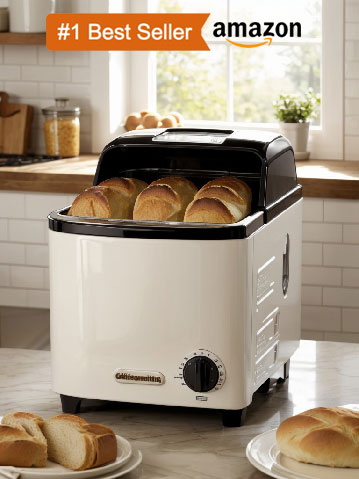What Is The Right Room Temperature For Bread Machine
Bread machines are an essential appliance in many kitchens. They can make baking bread much simpler and quicker than traditional methods. The right room temperature for a bread machine is important in order to ensure the bread turns out correctly.

The ideal temperature range for kneading dough in a bread machine is between 80-85°F (26-29°C).
Kneading dough in a bread machine is an important part of the bread-making process. It is important to keep the temperature of the dough in a range that will allow the yeast to activate properly and help the bread rise. The ideal temperature for kneading dough in a bread machine is between 80-85°F (26-29°C).
If the temperature is too low, the yeast will not be able to activate, resulting in a dense, heavy loaf with little rise. If the temperature is too high, the yeast will over-activate, leading to a loaf with excessive rise and a crumbly texture. It is important to ensure that the dough is at the correct temperature before adding it to your bread machine, as this will ensure that you get the best possible results.
When using a bread machine, ingredients should be added in the order recommended by the manufacturer.
When using a bread machine, it is important to add ingredients in the order recommended by the manufacturer. Different machines may require different orders of adding ingredients, so it is important to refer to the user manual for the exact order. Generally, liquid ingredients such as water, oil, and eggs should be added first, followed by dry ingredients such as flour, sugar, salt, and yeast.
It is especially important to add the yeast last, as it should never come into contact with liquid until the kneading begins. Many bread machines will have an ingredient order reminder that displays on the LCD screen to ensure that ingredients are added in the correct order. Following the manufacturer's instructions and adding ingredients in the correct order helps to ensure the best results from your bread machine.
See also: Making Homemade Biscuits In A Bread Machine
If you are using a bread machine that does not have a pre-programmed setting for dough, use the dough or manual settings.
The dough or manual setting on bread machines is typically used when you want to make dough but not actually bake the bread. This setting is convenient for when you want to shape your dough and bake the bread in your oven, or if you want to create a unique recipe that your bread machine doesn't have a pre-programmed setting for. When using the dough or manual setting, be sure to add all of the ingredients into the bread machine in the order that is specified in your recipe.
The machine will then mix and knead the dough, allowing you to shape it and bake it in your oven. Many bread machines will also have an automatic rise cycle, which will help to ensure that your dough rises properly before you bake it.
See also: Bobby Flay Pizza Dough In Bread Machine
The ideal temperature for rising dough in a bread machine is between 75-80°F (24-27°C).
Bread machines are an excellent tool for making homemade bread. To get the best results, it is important to ensure that the dough is rising at the right temperature. The ideal temperature for rising dough in a bread machine is between 75-80°F (24-27°C).
This temperature range is warm enough to activate the yeast, but not so hot that it will kill the yeast and prevent the dough from rising. If the temperature of the environment is too low, it can take significantly longer for the dough to rise. On the other hand, too high of a temperature can cause the dough to rise too quickly, resulting in a dense and heavy final product. By regulating the temperature while your dough is rising, you can ensure that your homemade bread turns out perfectly every time.
See also: Using Bread Machine To Proof Dough For Pizza
When using a bread machine, use fresh ingredients for best results.
Using a bread machine is a convenient way to make fresh bread at home. For best results, it is important to use fresh ingredients when making bread in the bread machine. Fresh flour, yeast, and other ingredients will help ensure the bread rises properly and has a good texture.
It is also important to measure the ingredients carefully and follow the instructions in the recipe closely. If the recipe or instructions call for room-temperature ingredients, make sure to follow that recommendation as well. If a recipe calls for water, use filtered or bottled water. This will help ensure that the bread comes out tasting its best. Using fresh ingredients is important for ensuring that the bread machine produces delicious and fresh-tasting bread.
See also: Easy Bear Bread In Tgd Bread Machine
Make sure the yeast used is suitable for the type of bread being made, such as active dry yeast for regular unleavened breads and instant yeast for doughs with sugar.
When baking bread, it is important to use the correct type of yeast for the best possible results. Active dry yeast is often the preferred choice for baking regular unleavened breads, as it is able to quickly and effectively raise the dough without imparting too much flavor. On the other hand, instant yeast is best suited for doughs with added sugar, as it is able to ferment quickly, creating a light and airy texture.
When using instant yeast, it is important to dissolve it first in warm water before adding it to the other ingredients. This process helps activate the yeast and ensures that it will effectively raise the dough. Using the wrong type of yeast can lead to poor results, so always be sure to read the instructions and use the yeast that is specifically recommended for your recipe.
See also: Mr Loaf Bread Machine Paddle Won'T Turn
If you are making a sweet dough, the sugar should be added after the yeast has been activated.
When making a sweet dough, it is important to add the sugar in the right order. The first step is to activate the yeast by combining it with warm water and a small amount of sugar. This creates an environment for the yeast to grow, and helps to improve the texture of the dough.
Once the yeast has been activated, the remaining sugar can then be added. The sugar helps to add flavor and sweetness to the dough, as well as aiding in the rising process. It is important to mix the sugar into the dough thoroughly, so that it is evenly distributed. Once all of the ingredients have been combined, the dough should be kneaded until it is smooth and elastic. After this step, the dough can be left to rise and then shaped into whatever desired form before baking.
When making dough in a bread machine, make sure the water used is lukewarm and not too hot.
When making dough in a bread machine, it is important to use lukewarm water. Too hot of water can actually harm the bread machine and also cause your dough to turn out too dense or even ruin the flavor of your dough. If the water is too hot, it can also cause the yeast to become inactive, resulting in an unevenly risen loaf of bread.
To ensure the best results, use water that is lukewarm to the touch. This means that it should feel just slightly warmer than body temperature when placed on your skin. The ideal temperature for lukewarm water should be around 75-80 degrees Fahrenheit (or 24-27 degrees Celsius). Make sure to test the temperature with a thermometer before adding it to the bread machine. Doing this will ensure your dough comes out perfect every time.
When making dough in a bread machine, use only enough flour as needed to make a soft, pliable dough.
When making dough in a bread machine, it is important to use the right amount of flour. Too little flour will result in a wet, sticky dough that will be difficult to work with. Too much flour will result in a dry, crumbly dough.
The ideal dough should be soft and pliable. To achieve this, start by adding the recommended amount of flour according to the recipe instructions. Then, add additional flour one tablespoon at a time until the dough pulls away from the sides of the machine and is no longer sticky. You may need to adjust the amount of liquid or add some additional gluten depending on the type of flour you are using. Once you have achieved the desired consistency, the dough is ready to be used as desired.
When the dough has finished kneading, it should be soft, smooth and slightly tacky to the touch.
After kneading the dough, it should have a soft, smooth texture with a slight tackiness. The dough should not be dry or stiff, but should yield slightly when pressed. It should feel resilient and slightly elastic, with a slight sheen on the surface.
If the dough has been kneaded correctly, it should not stick to your hands. If it feels too dry, add a small amount of water and knead it in. If it feels too sticky, add a small amount of flour and knead it in. After kneading the dough, it should be ready for proofing or baking.





